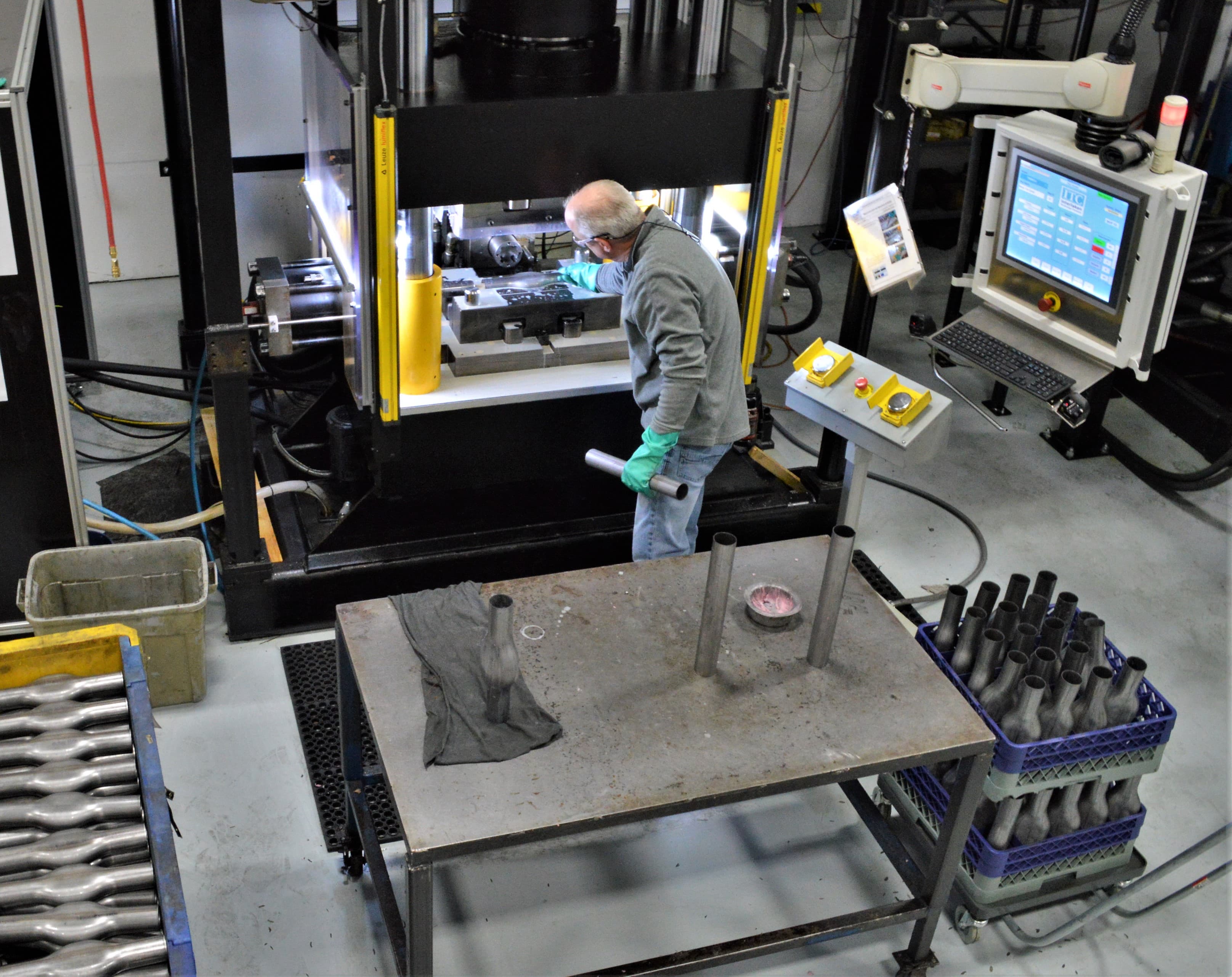
Making an impression
Submitted by:
Sara Waddington
Making an impression
A selection of the latest stamping technologies, tooling and press models come under the spotlight in the February 2024 issue of ISMR.
xxxx
The global metal stamping market size is expected to reach US$ 310.69 billion by 2030, registering a CAGR of 4.9% from 2023 to 2030 according to a report last year by analyst, Grand View Research.
There are four main types of metal stamping processes: progressive die stamping, transfer die stamping, four-slide stamping and fine blanking. Within each of these stamping processes, various stamping techniques are employed. These can include punching or perforating (to remove scrap pieces from the metal sheet as a punch enters the die); blanking; bending; coining (leaving an impression in a metal workpiece’s surface); flanging (using a flange or flare tool to create a joint in the metal sheet which connects multiple components) and embossing. Hot stamping entails heating the material until it becomes malleable. It is subsequently subjected to a formation and rapid cooling process to produce transformed and hardened material.
Some of the most common types of metal stamping machines include mechanical, hydraulic and servo presses that are fitted with multiple dies to cut and shape metal sheets of stainless steel and metals such as aluminium, zinc and copper. Better control, greater speed and versatility, shorter cycle times and higher energy savings are just some of the hallmarks of the latest technologies. In this article, we highlight an alphabetical selection of the latest new global stamping and pressing innovations.
An eye on innovation
AIDA debuted its NSX mechanical stamping press at FABTECH 2023 in Chicago, USA, last September. This two-point; 110-metric ton unitised frame press is capable of speeds ranging from 120-300 strokes per minute. It features a zero clearance; lubrication-free; eight-point roller slide guide system and dual counter-rotating eccentric shafts. Press and die integrity are protected by AIDA’s metal seal type Hydraulic Overload Protection (HOLP) at 10 milliseconds to zero pressure.
Two product lines that are dedicated to the production of motor laminations are the AIDA HMX Series and AIDA MSP Series presses. The AIDA MSP press enables users to produce motors such as EV motors, HEV motors and energy-efficient home appliance motors.
AIDA’s new DSF-NE2 presses are equipped with their own low-RPM, high-torque servo motor for metalforming applications. Its DSF-TE4 servo transfer presses (double-column split presses designed for transfer applications) offer high levels of customisation through multiple configurations. AIDA’s press line series also includes servo presses, high-speed automatic presses for lamination and precision forming presses.
AIDA-America introduced its DSF-N2-AB Series direct drive, two-point, unitised frame servo presses, available in 200 and 300 metric ton models, in October last year. At Blechexpo in November 2023, visitors to AIDA’s stand saw DSF-NE2 monoblock servo presses as well as the entire AIDA press line series including servo presses, high-speed automatic presses for lamination and precision forming presses.
Swedish press specialist, AP&T, is introducing a new version of its servo-hydraulic press with even lower energy consumption than before. The new version is primarily intended for progressive die stamping which requires a large number of strokes per minute and for other types of forming requiring precision such as embossing, punching and deep drawing.
AP&T's engineers have equipped the press with a closed, robust hydraulic system with a small oil volume and few components. Thanks to the modular system, each press can be optimised to use one or more cylinders depending upon the application.
“We are also introducing a new Android-based tool that simplifies remote problem solving and reduces the risk of misunderstandings and downtime,” added AP&T.
AP&T is now adding factory-rebuilt presses to its customer offering. These are older machines that AP&T's facility in Tranemo, Sweden have rebuilt and upgraded to meet current performance and safety requirements.
Italian manufacturer Balconi Presseccentriche S.p.A. produces transfer, blanking and servo presses as well as presses for progressive tools, impact extrusion presses and fin die presses. Its press model 4DMRF-LD-2000 has a 2,000kN cushion and three-axis electronic transfer. The press can produce up to 27 strokes per minute.
Boldrini is a manufacturer of hydraulic dished-end presses, flanging machines and manipulators. They feature high speeds including approach, return and, particularly, pressure build-up timing that, it told ISMR, results in a substantial increase in head production.
Swiss stamping specialist, Bruderer AG, unveiled two new presses at the Blechexpo exhibition in Stuttgart, Germany, last November. It introduced the BSTA 710-220 and the BSTL 350-88 models (the latter for customers involved in volume production of small and miniature components).
“As a fixed-stroke press, the BSTL uses up to 30% less energy when compared to older machine models. It comes with a new-generation servo feed unit,” commented Bruderer.
The BSTA 710-220, said Bruderer, offers “the longest bed length (2.2 metres) of its machine type in the world.” With automatic stroke adjustment and various options such as different stroke lengths, shut heights and press force monitoring (for example), the press can be configured for individual customer requirements.
Bruderer employs some 460 people worldwide, 370 of whom work at the Frasnacht site in Switzerland where all its stamping presses are produced.
Taiwanese manufacturer Chin Fong’s stamping presses range from 20-ton single crank presses and up to 3200 metric tons of capacity to four-point eccentric gear-driven, large panel and multi-stage transfer presses. Forging presses are further diversified by cold, warm and hot forging processes. It has also developed an intelligent single-crank press with a crank mechanism used for blanking, drawing, bending and partial forming. Its straightside double-crank power press, with 400-ton capacity, has a bed area of 2.5m x 1m and can produce metal stampings from material measuring up to 400mm wide and 3.5mm thick.
Established in 1948, Chin Fong now has offices in Taiwan, China, Indonesia, Malaysia, Thailand and the USA as well as representatives in numerous countries around the world. Its A0 tandem press line for the automotive industry includes stages such as deep drawing, trimming, piercing etc.
The company has moved onto multi-press connections and cloud computing, linking ERP management and even AI computing systems to analyse Big Data. It offers machine selection consulting services, combined with its “iForming PMS - Intelligent Forming Productivity Management System” solution. It has also implemented scanning code and fingerprint authentication to meet workplace safety requirements, as well as facial recognition and an iris recognition system.
COSKUNÖZ KALIP MAKINA SANAYI VE TICARET A.S. offers turnkey solution to OEMs for stamping tooling, with upstream and downstream services which include engineering feasibility at vehicle design stage; HLTO services; die repair and maintenance; prototype dies/parts and project management.
DEES Hydraulic Industrial Co., Ltd. is a hydraulic press manufacturer with factories in Taiwan and China. Its main products include presses such as custom triple-action; die spotting; die tryout; deep- drawing; transfer; servo controlled; tandem line; hot forming four-post; hemming; C-frame etc. Its focus is on three main stamping areas - servo motors, higher speed of the hydraulic press and higher productivity for presses, using accumulators for shorter strokes. DEES Hydraulic has also successfully developed a closed loop, hydraulic, servo-controlled die spotting press.
DEES has introduced a 24-hour 2,500-ton tandem line customised for automotive manufacturing industry. The hydraulic monoblock system is powered by a motor and pump set. The moving bolsters are enhanced with a QDS system (quick die-change system) to make the heavy die change easier and faster. Users can adjust pressure, speed, daylight and stroke distance.
The high-speed technology of the HD series developed by DEES is controlled by the accumulator. Its pressing speed is between 30-150mm/second, with an approaching speed of 800mm/second or faster and return speed of 600mm/second or faster. With the cushion system function to knock out the parts, all speeds and strokes including the slide and cushion systems are adjustable. DEES’s self-developed HD-FASTech technology has been designed to improve deep drawing/production efficiency.
ebu Umformtechnik (ebu) designs automatic punching machines, presses and automation from the conveyor system to parts management. It showcased its new HMI (human-machine interface) with Siemens Unified Panel at the Blechexpo exhibition in Stuttgart last November. The HMI is cloud- and web- ready and multi-touch gestures as well as zooming functionality is possible.
To read the rest of this article in the February 2024 issue of ISMR, see https://joom.ag/HU0d/p52
